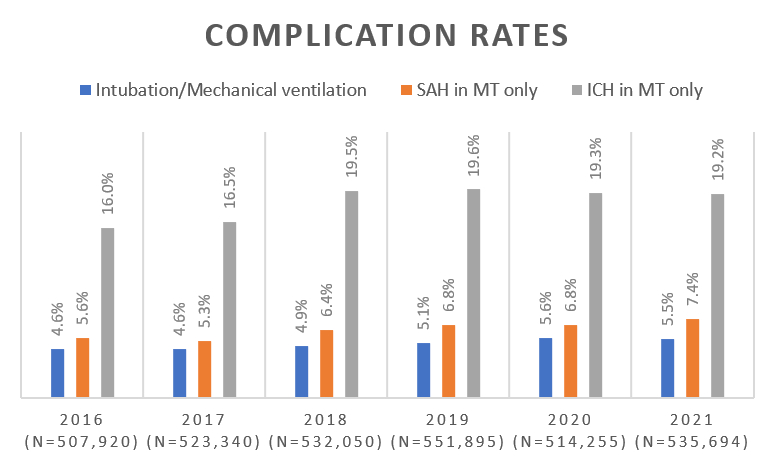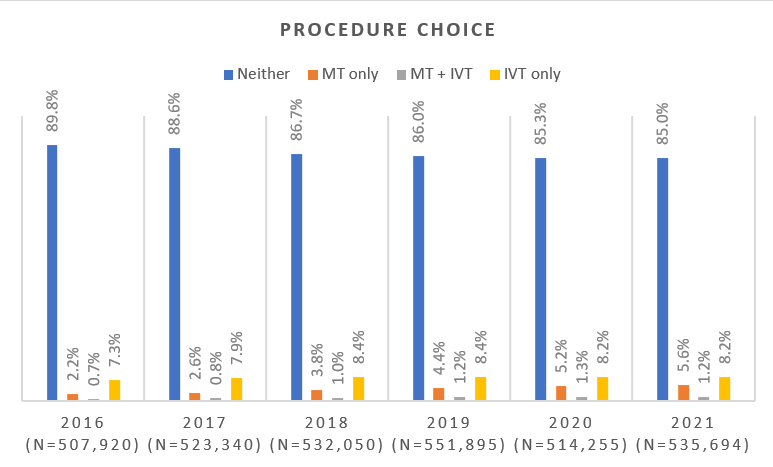Final ID: WMP76
Trends in ischemic stroke hospitalization and outcomes in the United States pre- and peri- COVID-19 pandemic: A National Inpatient Sample study
Abstract Body: Importance: The COVID-19 pandemic significantly disrupted healthcare systems worldwide, impacting the management of acute ischemic stroke (AIS). Understanding changes in AIS admissions, treatment patterns & outcomes during the pandemic is essential for optimizing stroke care in future public health crises.
Objective: To evaluate the impact of the COVID-19 pandemic on AIS admissions, treatment utilization, complications & outcomes in the U.S. from 2016 to 2021, focusing on the pre-pandemic (2016-2019) & peri-pandemic (2020-2021) periods.
Methods: A retrospective observational cohort study utilizing the National Inpatient Sample (NIS) nationwide database, analyzing weighted hospital discharge records over 6 years, encompassing urban, rural, teaching &non-teaching hospitals.
Participants were AIS patients aged 18 years & older (n=3,154,154), identified using ICD-10 codes. Sociodemographic characteristics such as age, sex, race & comorbidities were evaluated. The mean patient age was 70.0 ± 0.03 years, with an average length of stay of 5.1 ± 0.01 days & an adjusted mean cost of $16,765 ± 71. Men accounted for 50.5% of the cohort. AIS hospitalizations from 2016 to 2021 were collected, comparing pre- & peri-pandemic periods. Primary outcomes included AIS admission trends, while secondary outcomes included reperfusion therapy utilization, intubation & ventilation rates, discharge disposition & complications.
Results: AIS admissions increased from 507,920 in 2016 to 535,694 in 2021. A demographic shift was observed, with the proportion of male patients rising from 49.8% to 51.4% & the mean age decreasing from 70.3 to 69.7 years (p < 0.0001). Most patients were White (69.5% in 2016), but their proportion decreased over time, while Black, Hispanic & Asian/Pacific Islander cases increased (p 0.5734). Reperfusion therapy usage increased, with mechanical thrombectomy (MT) rising from 2.2% to 5.6% in 6 years. Intubation/ventilation rates grew from 4.8% pre-COVID to 5.5% peri-COVID (p < 0.0001). Subarachnoid & intracerebral hemorrhage rates had increased throughout the 6 years in the group with MT-only intervention (p .011 & .002, respectively).
Conclusions: The COVID-19 pandemic led to significant shifts in AIS hospitalization patterns, including changes in age distribution, increased reperfusion therapy use & rising complications. These findings highlight the need for adaptive public health strategies & resource allocation to maintain stroke care during future crises.
Objective: To evaluate the impact of the COVID-19 pandemic on AIS admissions, treatment utilization, complications & outcomes in the U.S. from 2016 to 2021, focusing on the pre-pandemic (2016-2019) & peri-pandemic (2020-2021) periods.
Methods: A retrospective observational cohort study utilizing the National Inpatient Sample (NIS) nationwide database, analyzing weighted hospital discharge records over 6 years, encompassing urban, rural, teaching &non-teaching hospitals.
Participants were AIS patients aged 18 years & older (n=3,154,154), identified using ICD-10 codes. Sociodemographic characteristics such as age, sex, race & comorbidities were evaluated. The mean patient age was 70.0 ± 0.03 years, with an average length of stay of 5.1 ± 0.01 days & an adjusted mean cost of $16,765 ± 71. Men accounted for 50.5% of the cohort. AIS hospitalizations from 2016 to 2021 were collected, comparing pre- & peri-pandemic periods. Primary outcomes included AIS admission trends, while secondary outcomes included reperfusion therapy utilization, intubation & ventilation rates, discharge disposition & complications.
Results: AIS admissions increased from 507,920 in 2016 to 535,694 in 2021. A demographic shift was observed, with the proportion of male patients rising from 49.8% to 51.4% & the mean age decreasing from 70.3 to 69.7 years (p < 0.0001). Most patients were White (69.5% in 2016), but their proportion decreased over time, while Black, Hispanic & Asian/Pacific Islander cases increased (p 0.5734). Reperfusion therapy usage increased, with mechanical thrombectomy (MT) rising from 2.2% to 5.6% in 6 years. Intubation/ventilation rates grew from 4.8% pre-COVID to 5.5% peri-COVID (p < 0.0001). Subarachnoid & intracerebral hemorrhage rates had increased throughout the 6 years in the group with MT-only intervention (p .011 & .002, respectively).
Conclusions: The COVID-19 pandemic led to significant shifts in AIS hospitalization patterns, including changes in age distribution, increased reperfusion therapy use & rising complications. These findings highlight the need for adaptive public health strategies & resource allocation to maintain stroke care during future crises.
More abstracts on this topic:
Does the use of CT perfusion (CTP) increase treatment rate of endovascular thrombectomy (EVT) in acute ischemic stroke patients?
Marginean Horia, Stuchiner Tamela, Hallak Patrice, Tarpley Jason
A Novel Imaging Biomarker to Make Precise Outcome Predictions for Patients with Acute Ischemic StrokeMallavarapu Monica, Kim Hyun Woo, Iyyangar Ananya, Salazar-marioni Sergio, Yoo Albert, Giancardo Luca, Sheth Sunil, Jeevarajan Jerome
Readers' Comments
We encourage you to enter the discussion by posting your comments and questions below.
Presenters will be notified of your post so that they can respond as appropriate.
This discussion platform is provided to foster engagement, and simulate conversation and knowledge sharing.
You have to be authorized to post a comment. Please, Login or Signup.
Rate this abstract
(Maximum characters: 500)



